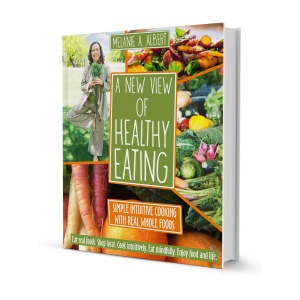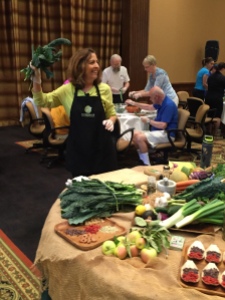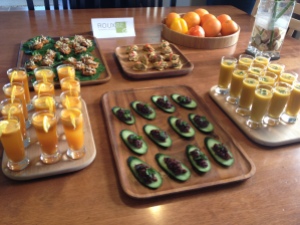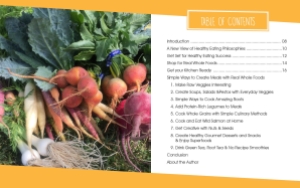by Melanie A.Albert, Intuitive Cooking Expert, Author, Speaker, Founder & CEO Experience Nutrition
As many of you are aware I have been extremely laser focused on the writing, editing,and designing of my new book, A New View of Healthy Eating, Simple Intuitive Cooking with Real Whole Foods. The book itself starting in November 2015, 8 months ago, but in reality, it started decades ago. Some of you have heard some of my stories about why I am passionate about healthy eating and cooking. I wanted to share with you the introduction of the book, which highlights my journey since 1993 when I was first really aware of the power of food.

INTRODUCTION
I initially learned first-hand the power of eating real whole foods over 20 years ago, in 1993, when my Mom, then 65 years old, was diagnosed with stage IV breast cancer and the conventional doctors gave her six months to live. Mom had the mastectomy, chemo, and radiation, and I left my successful corporate marketing career to be with her and my dad. I read nutrition books (there were only a few at the time). I had already stopped eating meat in the early 1980’s when I noticed that my body could not metabolize it and I intuitively started eating organic food in the early 1990’s. After Mom’s cancer diagnosis, I developed a plant-based way of eating for my parents, and with Mom’s positive outlook on life, I’m happy to say that as I write this, my mom is now 86 years old and very happy living in Cocoa Beach, Florida with my dad.
From 2008 to 2011, during four Super Bowl weeks, I was honored to have been active in numerous events with former NFL and Hall of Fame players by offering Super Bowl branded healthy lifestyle products, nutrition education, and healthy organic catering.
 In 2009, while talking with former NFL players during Super Bowl XLIII week in Tampa, I learned about the serious health issues – obesity, diabetes, heart disease, and pain – experienced by retired NFL players of the 1970’s. I intuitively knew that these health issues could be positively improved through food. For several years, I went into the kitchens of a number of former NFL players and their wives and taught them simple ways to cook healthy meals with whole foods. In 2011 my company, Experience Nutrition, was honored to be an official Health and Wellness Partner of the NFL Alumni Association.
In 2009, while talking with former NFL players during Super Bowl XLIII week in Tampa, I learned about the serious health issues – obesity, diabetes, heart disease, and pain – experienced by retired NFL players of the 1970’s. I intuitively knew that these health issues could be positively improved through food. For several years, I went into the kitchens of a number of former NFL players and their wives and taught them simple ways to cook healthy meals with whole foods. In 2011 my company, Experience Nutrition, was honored to be an official Health and Wellness Partner of the NFL Alumni Association.
During the last few years, my teaching about sound nutrition through hands-on, interactive, intuitive cooking classes, workshops, demos, and retreats with real whole foods has expanded. I’m honored to teach Whole Foods Cooking and Conscious Eating courses at the private college Southwest Institute of Healing Arts and I have led intuitive eating sessions at the Spirit of Yoga in Tempe, Arizona.

I’m grateful to present healthy eating and whole food cooking education during employee meetings, conferences, events, and retreats with organizations such as the City of Phoenix, Food Day Phoenix, Marquette General Hospital Nutrition and Medicine Conference, Parkinson’s Wellness Recovery, The Mankind Project, Gregory’s Fresh Market, Whole Foods Market, and Yoga Rocks the Park. I also love inspiring our youth to get excited about eating healthy food with organizations such as Desert Vista High School, The First Tee of Phoenix, Future for Kids, Phoenix Suns/Mercury Kids Camps, and Arizona Youth Sports Day.
I’ve learned first-hand with thousands of people the value of simple cooking with a few basic culinary techniques using easy-to-prepare recipes, and then intuitively creating beautiful, tasty meals with local, in-season, real whole foods.
I realized that the hands-on interactive nutrition and intuitive cooking programs that I had created and been teaching were so powerful and had positively changed the lives of so many people who took part in my classes, workshops, speaking engagements, retreats, and demos that I wanted to reach more people. As a result, I decided to write this book and create a handy companion motivational healthy eating card deck, as well as shoot videos and create online programs to encourage health, nutrition, and fun in the kitchen. My goal through these efforts is to inspire and motivate more people by working with organizations, non-profits, retreats, and holistic practitioners.
 It’s important to mention that I am not a professional chef, but I’ve learned how to cook with basic culinary techniques. I have taught and inspired others to do the same. I’ve extended my culinary expertise with cooking training in the Plant-Based Professional Certification with the Rouxbe Cooking School.
It’s important to mention that I am not a professional chef, but I’ve learned how to cook with basic culinary techniques. I have taught and inspired others to do the same. I’ve extended my culinary expertise with cooking training in the Plant-Based Professional Certification with the Rouxbe Cooking School.
This book is a result of my experiences in the kitchens of former NFL players and their families, with cooking classes and workshops for holistic practitioners and yoga students, and with cooking demos for organizations. You’ll learn simple culinary techniques and methods (e.g., cooking with a bamboo steamer; shopping for the right knife for you) and nutrition tips (e.g., protein-rich plant foods). You’ll also learn how to intuitively cook plant-based dishes (and wild salmon) to create simple, delicious meals for yourself, your family, and your friends. So that you get the most out of this book, I recommend that you begin with the first three sections. The first section outlines my philosophies about food. The second will guide you through the process of getting your kitchen ready for healthy eating success, as it offers information about shopping for organic real whole foods. The third section will prepare you with the essential kitchen tools and foods for whole food cooking success.
So that you get the most out of this book, I recommend that you begin with the first three sections. The first section outlines my philosophies about food. The second will guide you through the process of getting your kitchen ready for healthy eating success, as it offers information about shopping for organic real whole foods. The third section will prepare you with the essential kitchen tools and foods for whole food cooking success.
After that, the book is organized by types of food and includes simple recipes, culinary cooking techniques, and nutrition tips. Chapters are organized into nine delicious whole food categories: Raw Veggies; Soups, Salads, and Pestos; Root Vegetables; Legumes; Whole Grains; Wild Salmon; Nuts and Seeds; Desserts, Snacks, and Superfoods; and Drinks. You may choose to learn from the book by starting at the beginning and going step by step through the food categories, or you might focus on the foods you’re most interested in learning how to cook.
It has been such a joy to create for you this intuitive cooking book with real whole foods. I now invite you to head to a farmers’ market, step into your kitchen, and have fun learning simple culinary techniques, intuitively creating meals with whole foods that are available in your market with the season.
Enjoy food & life!
Melanie A. Albert
Phoenix
 If you would like to pre-order A New View of Healthy Eating, your copy will arrive in the first print order in late August 2016 / September 2016. Here’s a link to make it easy for you, if you wish to order now. Thanks so much!
If you would like to pre-order A New View of Healthy Eating, your copy will arrive in the first print order in late August 2016 / September 2016. Here’s a link to make it easy for you, if you wish to order now. Thanks so much!
Pre-order the book today and receive Top 5 Recipes and Culinary Tips.
STEP 1: Pre-order Book

STEP 2: Fill out this form and receive the Top 5 Recipes & Culinary Tips.
![]()
































































 In 2009, while talking with former NFL players during Super Bowl XLIII week in Tampa, I learned about the serious health issues – obesity, diabetes, heart disease, and pain – experienced by retired NFL players of the 1970’s. I intuitively knew that these health issues could be positively improved through food. For several years, I went into the kitchens of a number of former NFL players and their wives and taught them simple ways to cook healthy meals with whole foods. In 2011 my company, Experience Nutrition, was honored to be an official Health and Wellness Partner of the NFL Alumni Association.
In 2009, while talking with former NFL players during Super Bowl XLIII week in Tampa, I learned about the serious health issues – obesity, diabetes, heart disease, and pain – experienced by retired NFL players of the 1970’s. I intuitively knew that these health issues could be positively improved through food. For several years, I went into the kitchens of a number of former NFL players and their wives and taught them simple ways to cook healthy meals with whole foods. In 2011 my company, Experience Nutrition, was honored to be an official Health and Wellness Partner of the NFL Alumni Association.












